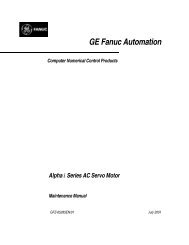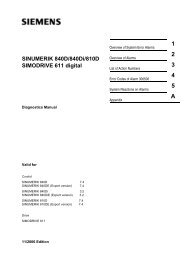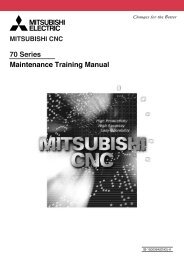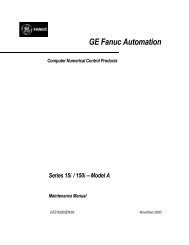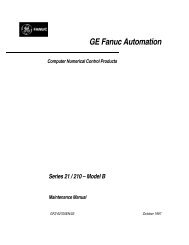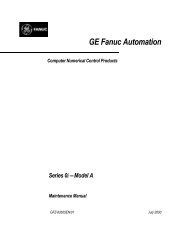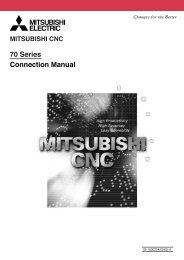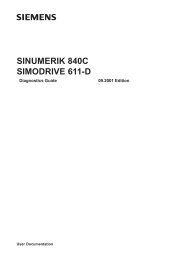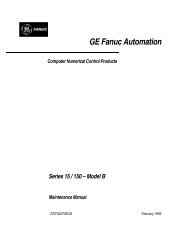- Page 1:
GE Fanuc AutomationComputer Numeric
- Page 4 and 5:
B-62755EN/01PREFACEPREFACEDescripti
- Page 6 and 7:
B-62755EN/01PREFACERelated manualsT
- Page 10 and 11:
B-62755EN/01 2.7 HOW TO REPLACE TH
- Page 12:
B-62755EN/01 7. AC SPINDLE (ANALOG
- Page 15 and 16:
B-62755EN/011DISPLAYAND OPERATION O
- Page 17 and 18:
B-62755EN/011. DISPLAY AND OPERATIO
- Page 19 and 20:
B-62755EN/011. DISPLAY AND OPERATIO
- Page 21 and 22:
B-62755EN/011. DISPLAY AND OPERATIO
- Page 23 and 24:
B-62755EN/011. DISPLAY AND OPERATIO
- Page 25 and 26:
B-62755EN/011. DISPLAY AND OPERATIO
- Page 27 and 28:
B-62755EN/011. DISPLAY AND OPERATIO
- Page 29 and 30:
B-62755EN/011. DISPLAY AND OPERATIO
- Page 31 and 32:
B-62755EN/011. DISPLAY AND OPERATIO
- Page 33 and 34:
B-62755EN/011. DISPLAY AND OPERATIO
- Page 35 and 36:
B-62755EN/011. DISPLAY AND OPERATIO
- Page 37 and 38:
B-62755EN/011. DISPLAY AND OPERATIO
- Page 39 and 40:
B-62755EN/011. DISPLAY AND OPERATIO
- Page 41 and 42:
B-62755EN/011. DISPLAY AND OPERATIO
- Page 43 and 44:
B-62755EN/011. DISPLAY AND OPERATIO
- Page 45 and 46:
B-62755EN/011. DISPLAY AND OPERATIO
- Page 47 and 48:
B-62755EN/011. DISPLAY AND OPERATIO
- Page 49 and 50:
B-62755EN/011. DISPLAY AND OPERATIO
- Page 51 and 52:
B-62755EN/011. DISPLAY AND OPERATIO
- Page 53 and 54:
B-62755EN/011. DISPLAY AND OPERATIO
- Page 55 and 56:
B-62755EN/011. DISPLAY AND OPERATIO
- Page 57 and 58:
B-62755EN/011. DISPLAY AND OPERATIO
- Page 59 and 60:
B-62755EN/011. DISPLAY AND OPERATIO
- Page 61 and 62:
B-62755EN/011. DISPLAY AND OPERATIO
- Page 63 and 64:
B-62755EN/011. DISPLAY AND OPERATIO
- Page 65 and 66:
B-62755EN/011. DISPLAY AND OPERATIO
- Page 67 and 68:
B-62755EN/011. DISPLAY AND OPERATIO
- Page 69 and 70:
B-62755EN/011. DISPLAY AND OPERATIO
- Page 71 and 72:
B-62755EN/011. DISPLAY AND OPERATIO
- Page 73 and 74:
B-62755EN/011. DISPLAY AND OPERATIO
- Page 75 and 76:
B-62755EN/011. DISPLAY AND OPERATIO
- Page 77 and 78:
B-62755EN/011. DISPLAY AND OPERATIO
- Page 79 and 80:
B-62755EN/011. DISPLAY AND OPERATIO
- Page 81 and 82:
B-62755EN/011. DISPLAY AND OPERATIO
- Page 83 and 84:
B-62755EN/011. DISPLAY AND OPERATIO
- Page 85 and 86:
B-62755EN/011. DISPLAY AND OPERATIO
- Page 87 and 88:
B-62755EN/011. DISPLAY AND OPERATIO
- Page 89 and 90:
B-62755EN/011. DISPLAY AND OPERATIO
- Page 91 and 92:
B-62755EN/011. DISPLAY AND OPERATIO
- Page 93 and 94:
B-62755EN/011. DISPLAY AND OPERATIO
- Page 95 and 96:
B-62755EN/011. DISPLAY AND OPERATIO
- Page 97 and 98:
B-62755EN/011. DISPLAY AND OPERATIO
- Page 99 and 100:
B-62755EN/011. DISPLAY AND OPERATIO
- Page 101 and 102:
B-62755EN/011. DISPLAY AND OPERATIO
- Page 103 and 104:
B-62755EN/011. DISPLAY AND OPERATIO
- Page 105 and 106:
B-62755EN/012. HARDWARE2.1STRUCTURE
- Page 107 and 108:
ÈÈÈÈÈÈÈÈÈÈÈÈÈÈÈÈÈ
- Page 109 and 110:
B-62755EN/012. HARDWARE(Main CPU)SE
- Page 111 and 112:
B-62755EN/012. HARDWARESCALE1 (JF21
- Page 113 and 114:
B-62755EN/012. HARDWARE2) When the
- Page 115 and 116:
B-62755EN/012. HARDWARE4) When the
- Page 117 and 118:
B-62755EN/012. HARDWARE Terminal la
- Page 119 and 120:
B-62755EN/012. HARDWARE3) For 14″
- Page 121 and 122:
B-62755EN/012. HARDWARE2.4.2Reader/
- Page 123 and 124:
B-62755EN/012. HARDWARE2.4.4I/O LIN
- Page 125 and 126:
B-62755EN/012. HARDWARE Cable conne
- Page 127 and 128:
B-62755EN/012. HARDWARE Connection
- Page 129 and 130:
B-62755EN/012. HARDWARE2.4.6Connect
- Page 131 and 132:
B-62755EN/012. HARDWARE Serial spin
- Page 133 and 134:
B-62755EN/012. HARDWARE2.4.9Connect
- Page 135 and 136:
B-62755EN/012. HARDWARE2.4.11Remote
- Page 137 and 138:
B-62755EN/012. HARDWARE2.4.12High-s
- Page 139 and 140:
B-62755EN/012. HARDWARE2.4.14Enviro
- Page 141 and 142:
B-62755EN/012. HARDWARE GroundThe f
- Page 143 and 144:
B-62755EN/012. HARDWARE Noise suppr
- Page 145 and 146:
B-62755EN/012. HARDWARE2.5LED DISPL
- Page 147 and 148:
B-62755EN/012. HARDWARE FuseFusesPo
- Page 149 and 150:
B-62755EN/012. HARDWARE2.5.2Main CP
- Page 151 and 152:
B-62755EN/012. HARDWARENo. Name Spe
- Page 153 and 154:
B-62755EN/012. HARDWARE2.5.4Option
- Page 155 and 156:
B-62755EN/012. HARDWARE Location of
- Page 157 and 158:
B-62755EN/012. HARDWARE2.5.5Option
- Page 159 and 160:
B-62755EN/012. HARDWARE Location of
- Page 161 and 162:
B-62755EN/012. HARDWARE Location of
- Page 163 and 164:
B-62755EN/012. HARDWARE2.5.9I/O Car
- Page 165 and 166:
B-62755EN/012. HARDWARE2.5.11Backgr
- Page 167 and 168:
B-62755EN/012. HARDWARE2.5.1264-bit
- Page 169 and 170:
B-62755EN/012. HARDWARE2.6.3Control
- Page 171 and 172:
B-62755EN/012. HARDWARE2.6.4Modules
- Page 173 and 174:
B-62755EN/012. HARDWARE2.6.5CRT/MDI
- Page 175 and 176:
B-62755EN/012. HARDWARENameSpecific
- Page 177 and 178:
B-62755EN/012. HARDWARENameSpecific
- Page 179 and 180:
B-62755EN/012. HARDWARENameSpecific
- Page 181 and 182:
B-62755EN/012. HARDWARE2.7HOW TO RE
- Page 183 and 184:
B-62755EN/012. HARDWARE2.8.1Replaci
- Page 185 and 186:
B-62755EN/012. HARDWARE2.8.3Replaci
- Page 187 and 188:
B-62755EN/012. HARDWARE(5)(4)Fan mo
- Page 189 and 190:
B-62755EN/012. HARDWARETable 1. Fus
- Page 191 and 192:
B-62755EN/012. HARDWARECleaning hea
- Page 193 and 194:
B-62755EN/012. HARDWARE2.12ADJUSTIN
- Page 195 and 196:
B-62755EN/012. HARDWARE2.13REPLACIN
- Page 197 and 198:
B-62755EN/013. INPUT AND OUTPUT OF
- Page 199 and 200:
B-62755EN/013. INPUT AND OUTPUT OF
- Page 201 and 202:
B-62755EN/013. INPUT AND OUTPUT OF
- Page 203 and 204:
B-62755EN/013. INPUT AND OUTPUT OF
- Page 205 and 206:
B-62755EN/013. INPUT AND OUTPUT OF
- Page 207 and 208:
B-62755EN/013. INPUT AND OUTPUT OF
- Page 209 and 210:
B-62755EN/013. INPUT AND OUTPUT OF
- Page 211 and 212:
B-62755EN/013. INPUT AND OUTPUT OF
- Page 213 and 214:
B-62755EN/013. INPUT AND OUTPUT OF
- Page 215 and 216:
B-62755EN/013. INPUT AND OUTPUT OF
- Page 217 and 218:
B-62755EN/013. INPUT AND OUTPUT OF
- Page 219 and 220:
B-62755EN/013. INPUT AND OUTPUT OF
- Page 221 and 222:
B-62755EN/013. INPUT AND OUTPUT OF
- Page 223 and 224:
B-62755EN/013. INPUT AND OUTPUT OF
- Page 225 and 226:
B-62755EN/014.INTERFACE BETWEEN NC
- Page 227 and 228:
B-62755EN/014.INTERFACE BETWEEN NC
- Page 229 and 230:
B-62755EN/014.INTERFACE BETWEEN NC
- Page 231 and 232:
B-62755EN/014.INTERFACE BETWEEN NC
- Page 233 and 234:
B-62755EN/014.INTERFACE BETWEEN NC
- Page 235 and 236:
B-62755EN/014.INTERFACE BETWEEN NC
- Page 237 and 238:
B-62755EN/014.INTERFACE BETWEEN NC
- Page 239 and 240:
B-62755EN/014.INTERFACE BETWEEN NC
- Page 241 and 242:
B-62755EN/014.INTERFACE BETWEEN NC
- Page 243 and 244:
B-62755EN/014.INTERFACE BETWEEN NC
- Page 245 and 246:
B-62755EN/014.INTERFACE BETWEEN NC
- Page 247 and 248:
B-62755EN/014.INTERFACE BETWEEN NC
- Page 249 and 250:
ÀÀÀÀÀÀÀÀÀÀÀÀB-62755EN/0
- Page 251 and 252:
B-62755EN/014.INTERFACE BETWEEN NC
- Page 253 and 254:
B-62755EN/014.INTERFACE BETWEEN NC
- Page 255 and 256:
B-62755EN/014.INTERFACE BETWEEN NC
- Page 257 and 258:
B-62755EN/014.INTERFACE BETWEEN NC
- Page 259 and 260:
B-62755EN/014.INTERFACE BETWEEN NC
- Page 261 and 262:
B-62755EN/015. DIGITAL SERVO5DIGITA
- Page 263 and 264:
B-62755EN/015. DIGITAL SERVO(2)MOTO
- Page 265 and 266:
B-62755EN/015. DIGITAL SERVO8) For
- Page 267 and 268:
B-62755EN/015. DIGITAL SERVO(8)No.
- Page 269 and 270:
B-62755EN/015. DIGITAL SERVOAlarm1#
- Page 271 and 272:
B-62755EN/015. DIGITAL SERVO5.3ADJU
- Page 273 and 274:
B-62755EN/015. DIGITAL SERVO5.4DOGL
- Page 275 and 276:
B-62755EN/016ACSPINDLE (SERIAL INTE
- Page 277 and 278:
B-62755EN/016. AC SPINDLE (SERIAL I
- Page 279 and 280:
B-62755EN/016. AC SPINDLE (SERIAL I
- Page 281 and 282:
B-62755EN/016. AC SPINDLE (SERIAL I
- Page 283 and 284:
B-62755EN/016. AC SPINDLE (SERIAL I
- Page 285 and 286:
B-62755EN/016. AC SPINDLE (SERIAL I
- Page 287 and 288:
B-62755EN/016. AC SPINDLE (SERIAL I
- Page 289 and 290:
B-62755EN/016. AC SPINDLE (SERIAL I
- Page 291 and 292:
B-62755EN/016. AC SPINDLE (SERIAL I
- Page 293 and 294:
B-62755EN/017. AC SPINDLE (ANALOG I
- Page 295 and 296:
B-62755EN/017. AC SPINDLE (ANALOG I
- Page 297 and 298:
B-62755EN/017. AC SPINDLE (ANALOG I
- Page 299 and 300:
B-62755EN/017. AC SPINDLE (ANALOG I
- Page 301 and 302:
B-62755EN/017. AC SPINDLE (ANALOG I
- Page 303 and 304:
B-62755EN/017. AC SPINDLE (ANALOG I
- Page 305 and 306:
B-62755EN/017. AC SPINDLE (ANALOG I
- Page 307 and 308:
B-62755EN/017. AC SPINDLE (ANALOG I
- Page 309 and 310:
B-62755EN/018.TROUBLESHOOTING8TROUB
- Page 311 and 312:
B-62755EN/018.TROUBLESHOOTING8.1COR
- Page 313 and 314:
B-62755EN/018.TROUBLESHOOTING8.2POW
- Page 315 and 316:
B-62755EN/018.TROUBLESHOOTINGMain C
- Page 317 and 318:
B-62755EN/018.TROUBLESHOOTING(c) Co
- Page 319 and 320:
B-62755EN/018.TROUBLESHOOTINGc. Jog
- Page 321 and 322:
B-62755EN/018.TROUBLESHOOTING(3)Che
- Page 323 and 324:
B-62755EN/018.TROUBLESHOOTINGc. Jog
- Page 325 and 326:
B-62755EN/018.TROUBLESHOOTINGG0019#
- Page 327 and 328:
B-62755EN/018.TROUBLESHOOTING8.6AUT
- Page 329 and 330:
B-62755EN/018.TROUBLESHOOTINGG0005#
- Page 331 and 332:
B-62755EN/018.TROUBLESHOOTINGf. Int
- Page 333 and 334:
B-62755EN/018.TROUBLESHOOTINGi. NC
- Page 335 and 336:
B-62755EN/018.TROUBLESHOOTING8.7CYC
- Page 337 and 338:
B-62755EN/018.TROUBLESHOOTING8.8NOT
- Page 339 and 340:
B-62755EN/018.TROUBLESHOOTING8.9ALA
- Page 341 and 342:
B-62755EN/018.TROUBLESHOOTING0102 T
- Page 343 and 344:
B-62755EN/018.TROUBLESHOOTING(c) Sp
- Page 345 and 346:
B-62755EN/018.TROUBLESHOOTING< Cabl
- Page 347 and 348:
B-62755EN/018.TROUBLESHOOTING8.10RE
- Page 349 and 350:
B-62755EN/018.TROUBLESHOOTING(1)Che
- Page 351 and 352: B-62755EN/018.TROUBLESHOOTING8.13AL
- Page 353 and 354: B-62755EN/018.TROUBLESHOOTING8.14AL
- Page 355 and 356: ÇÇÇÇÇÇB-62755EN/018.TROUBLESH
- Page 357 and 358: B-62755EN/018.TROUBLESHOOTING8.16AL
- Page 359 and 360: B-62755EN/018.TROUBLESHOOTING Overh
- Page 361 and 362: B-62755EN/018.TROUBLESHOOTINGPower
- Page 363 and 364: B-62755EN/018.TROUBLESHOOTING8.20AL
- Page 365 and 366: B-62755EN/018.TROUBLESHOOTINGMove t
- Page 367 and 368: B-62755EN/018.TROUBLESHOOTING #6(LV
- Page 369 and 370: B-62755EN/018.TROUBLESHOOTING #4(HC
- Page 371 and 372: B-62755EN/018.TROUBLESHOOTING #2(DC
- Page 373 and 374: B-62755EN/018.TROUBLESHOOTING #1(FB
- Page 375 and 376: B-62755EN/018.TROUBLESHOOTING LED d
- Page 377 and 378: B-62755EN/018.TROUBLESHOOTING Curre
- Page 379 and 380: B-62755EN/018.TROUBLESHOOTING8.24AL
- Page 381 and 382: B-62755EN/018.TROUBLESHOOTING8.26AL
- Page 383 and 384: B-62755EN/018.TROUBLESHOOTING Optio
- Page 385 and 386: B-62755EN/018.TROUBLESHOOTINGRemedi
- Page 387 and 388: B-62755EN/018.TROUBLESHOOTING8.29AL
- Page 389 and 390: B-62755EN/018.TROUBLESHOOTING8.31AL
- Page 391 and 392: B-62755EN/018.TROUBLESHOOTING8.32AL
- Page 393 and 394: B-62755EN/018.TROUBLESHOOTING Main
- Page 395 and 396: B-62755EN/018.TROUBLESHOOTING8.34AL
- Page 397 and 398: B-62755EN/018.TROUBLESHOOTING8.36AL
- Page 399 and 400: B-62755EN/018.TROUBLESHOOTING8.37AL
- Page 401: B-62755EN/018.TROUBLESHOOTING8.39AL
- Page 405 and 406: B-62755EN/019. TROUBLESHOOTING (SER
- Page 407 and 408: B-62755EN/019. TROUBLESHOOTING (SER
- Page 409 and 410: B-62755EN/019. TROUBLESHOOTING (SER
- Page 411 and 412: B-62755EN/019. TROUBLESHOOTING (SER
- Page 413 and 414: B-62755EN/0110. TROUBLESHOOTING(ANA
- Page 415 and 416: B-62755EN/0110. TROUBLESHOOTING(ANA
- Page 417 and 418: B-62755EN/0110. TROUBLESHOOTING(ANA
- Page 419 and 420: B-62755EN/0110. TROUBLESHOOTING(ANA
- Page 421 and 422: B-62755EN/0110. TROUBLESHOOTING(ANA
- Page 423 and 424: B-62755EN/0110. TROUBLESHOOTING(ANA
- Page 425 and 426: B-62755EN/01APPENDIXA. I/O UNIT MOD
- Page 427 and 428: B-62755EN/01APPENDIXA. I/O UNIT MOD
- Page 429 and 430: B-62755EN/01APPENDIXA. I/O UNIT MOD
- Page 431 and 432: B-62755EN/01APPENDIXB. ALARM LISTBA
- Page 433 and 434: B-62755EN/01APPENDIXB. ALARM LISTNu
- Page 435 and 436: B-62755EN/01APPENDIXB. ALARM LISTNu
- Page 437 and 438: B-62755EN/01APPENDIXB. ALARM LISTNu
- Page 439 and 440: B-62755EN/01APPENDIXB. ALARM LISTNu
- Page 441 and 442: B-62755EN/01APPENDIXB. ALARM LISTNu
- Page 443 and 444: B-62755EN/01APPENDIXB. ALARM LISTNu
- Page 445 and 446: B-62755EN/01APPENDIXB. ALARM LISTNu
- Page 447 and 448: B-62755EN/01APPENDIXB. ALARM LISTNu
- Page 449 and 450: B-62755EN/01APPENDIXB. ALARM LISTNu
- Page 451 and 452: B-62755EN/01APPENDIXB. ALARM LIST(4
- Page 453 and 454:
B-62755EN/01APPENDIXB. ALARM LISTNu
- Page 455 and 456:
B-62755EN/01APPENDIXB. ALARM LIST(8
- Page 457 and 458:
B-62755EN/01APPENDIXB. ALARM LISTNu
- Page 459 and 460:
B-62755EN/01APPENDIXB. ALARM LISTB.
- Page 461 and 462:
B-62755EN/01APPENDIXB. ALARM LISTMe
- Page 463 and 464:
B-62755EN/01APPENDIXB. ALARM LISTMe
- Page 467 and 468:
B-62755EN/01APPENDIXB. ALARM LISTMe
- Page 469 and 470:
B-62755EN/01APPENDIXB. ALARM LISTAl
- Page 471 and 472:
B-62755EN/01APPENDIXB. ALARM LISTB.
- Page 473 and 474:
B-62755EN/01APPENDIXB. ALARM LIST M
- Page 475 and 476:
B-62755EN/01APPENDIXC. LIST OF MAIN
- Page 477 and 478:
B-62755EN/01APPENDIXC. LIST OF MAIN
- Page 479 and 480:
B-62755EN/01APPENDIXC. LIST OF MAIN
- Page 481 and 482:
B-62755EN/01APPENDIXC. LIST OF MAIN
- Page 483 and 484:
B-62755EN/01APPENDIXC. LIST OF MAIN
- Page 485 and 486:
B-62755EN/01APPENDIXC. LIST OF MAIN
- Page 487 and 488:
B-62755EN/01APPENDIXC. LIST OF MAIN
- Page 489 and 490:
B-62755EN/01APPENDIXD. BOOT SYSTEMD
- Page 491 and 492:
B-62755EN/01APPENDIXD. BOOT SYSTEMD
- Page 493 and 494:
B-62755EN/01APPENDIXD. BOOT SYSTEMD
- Page 495 and 496:
B-62755EN/01APPENDIXD. BOOT SYSTEMD
- Page 497 and 498:
B-62755EN/01APPENDIXD. BOOT SYSTEMD
- Page 499 and 500:
B-62755EN/01APPENDIXD. BOOT SYSTEM
- Page 501 and 502:
B-62755EN/01APPENDIXD. BOOT SYSTEM
- Page 503 and 504:
B-62755EN/01APPENDIXD. BOOT SYSTEMD
- Page 505 and 506:
B-62755EN/01APPENDIXD. BOOT SYSTEMD
- Page 507 and 508:
B-62755EN/01APPENDIXD. BOOT SYSTEMD
- Page 509 and 510:
B-62755EN/01ENOTATIONAPPENDIXOF MDI
- Page 511 and 512:
B-62755EN/01Numbers16-TC/MC, 160-TC
- Page 513 and 514:
B-62755EN/01INDEXMMain CPU board, 1
- Page 515 and 516:
Revision RecordFANUC MAINTENANCE



